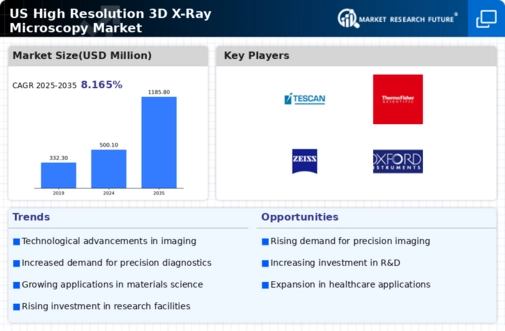Increased Research Funding
The high resolution-3d-x-ray-microscopy market is experiencing a surge in research funding from both public and private sectors. Government agencies, such as the National Institutes of Health (NIH), have allocated substantial budgets to enhance imaging technologies, which is likely to drive innovation in this field. In 2025, funding for advanced imaging techniques is projected to reach approximately $1.5 billion, reflecting a 20% increase from previous years. This influx of capital enables researchers to develop more sophisticated high resolution-3d-x-ray-microscopy systems, thereby expanding their applications in materials science, biology, and nanotechnology. As a result, the market is poised for growth, with institutions increasingly adopting these technologies to gain insights into complex structures at the micro and nano scales.
Technological Integration with AI
The integration of artificial intelligence (AI) into the high resolution-3d-x-ray-microscopy market is emerging as a transformative driver. AI algorithms can enhance image processing, automate analysis, and improve the accuracy of measurements. This technological synergy is expected to streamline workflows and reduce the time required for data interpretation. In 2025, it is anticipated that AI-enhanced systems will account for nearly 15% of the market, as researchers seek to leverage these advancements for more efficient and effective imaging solutions. The potential for AI to revolutionize data analysis in high resolution-3d-x-ray-microscopy suggests a promising future for the market, as it aligns with the growing trend of digital transformation in scientific research.
Growing Interest in Biological Imaging
The high resolution-3d-x-ray-microscopy market is experiencing a growing interest in biological imaging applications. Researchers in the life sciences are increasingly adopting these advanced imaging techniques to study cellular structures and processes in unprecedented detail. The ability to visualize biological specimens in three dimensions without the need for staining or sectioning is a game changer. In 2025, the biological imaging segment is projected to represent approximately 25% of the overall market, reflecting a shift towards non-invasive imaging methods. This trend indicates that as the demand for high-resolution imaging in biological research continues to rise, the high resolution-3d-x-ray-microscopy market will likely expand to meet these needs.
Rising Applications in Material Science
The high resolution-3d-x-ray-microscopy market is witnessing a notable rise in applications within the material science sector. Industries such as aerospace, automotive, and electronics are increasingly utilizing high resolution-3d-x-ray-microscopy for quality control and failure analysis. The ability to visualize internal structures without damaging samples is particularly valuable in these fields. In 2025, it is estimated that the material science segment will account for over 30% of the market share, driven by the need for precise characterization of materials. This trend suggests that as industries continue to prioritize quality and performance, the demand for high resolution-3d-x-ray-microscopy will likely increase, further solidifying its role in advanced manufacturing processes.
Increased Collaboration Between Academia and Industry
The high resolution-3d-x-ray-microscopy market is benefiting from increased collaboration between academic institutions and industry players. Partnerships are fostering innovation and facilitating the transfer of technology from research labs to commercial applications. This collaboration is particularly evident in the development of new imaging techniques and the refinement of existing systems. In 2025, it is projected that collaborative projects will contribute to a 10% increase in market growth, as both sectors work together to address challenges and explore new opportunities. This trend indicates that as academia and industry continue to align their goals, the high resolution-3d-x-ray-microscopy market will likely see accelerated advancements and broader adoption across various fields.















Leave a Comment